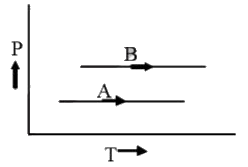In a process on a system, the initial pressure and volume.
The initial temperature must be equal to the final temperature.
the initial internal energy must be equal to the final internal energy.
the net heat given to the system in the process must be zero.
the net work done by the system in the process must be zero.
The correct Answer is:A, B
The initial tempreture must be equal to the final tempreture. , the initial internal energy must be equal to the final internal energy.
Topper's Solved these Questions
- LAWS OF THERMODYNAMICSBOOK - HC VERMACHAPTER - LAWS OF THERMODYNAMICSEXERCISE - Exercises
22 Videos
- LAWS OF THERMODYNAMICSBOOK - HC VERMACHAPTER - LAWS OF THERMODYNAMICSEXERCISE - Short Answer
15 Videos
- LAWS OF THERMODYNAMICSBOOK - HC VERMACHAPTER - LAWS OF THERMODYNAMICSEXERCISE - Objective 1
9 Videos
- KINETIC THEORY OF GASESBOOK - HC VERMACHAPTER - KINETIC THEORY OF GASESEXERCISE - Exercises
62 Videos
- NEWTON'S LAWS OF MOTIONBOOK - HC VERMACHAPTER - NEWTON'S LAWS OF MOTIONEXERCISE - Exercises
42 Videos
Similar Questions
In a process on a system in closed container, the initial pressure and volume are equal to the final pressure and volume :
View SolutionAn ideal gas has initial pressure of 3 presssure units and an initial volume units the table gives the final pressure and volume of the gas ( in those same units ) in five processes which processes start and end on the same isotherm ?

View Solution
Knowledge Check
For an ideal gas of fixed amount, the initial pressure and volume are equal to the final pressure and volume
AThe initial temperature must be equal to the final temperatureBThe initial internal energy must be equal to the final internal energy .CThe het heat given to an ideal gas in the process must be zeroDThe net work done by an ideal gas in the process may be zeroFigure shows a process on a gas in which pressure and volume both change. The molar heat capacity for this process is C.
AC=0BC=CvCC>CvDC<CvInitial volume of three samples of same gas A,BandC are same. The process A is adiabatic, B is isobaric and C is isothermal. Each of the sample has same final pressure and volume. The initial pressure of which sample was maximum.
AABBCCDSame pressure for all samples
An ideal gas has an initial pressure of 3 pressure units and an initial volume of 4 volume units. The table gives the final pressure and volume of the gas (in those same units) in four processes. Whish process starts and ends on the same isotherm

View SolutionConsider the two process on a system as shown in figure. The volumes in the initial state and in the final state are the same in the two process A and B. If W1 and W2 be the work done by the system in the processes A and B respectively then-

View SolutionA thermodynamic process is shown in the figure. The pressure and volumes corresponding to some points in the figure are

View SolutionA gas is filled in a cylinder with initial pressure P, initial volume V. When the pressure is increased by dP and volume reduces by dV. The bulk modulus is
View SolutionFor an ideal gas with initial pressure and volume Pi and Vi, respectively, a reversible isothermal expansion happers, when its volume becomes V0. Then it is compressed to its original volume Viby a reversible adiabatic process. If the final pressure is Pf, then which of the following statement is true?
View Solution
